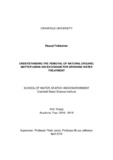JavaScript is disabled for your browser. Some features of this site may not work without it.
| dc.contributor.advisor | Jarvis, Peter | |
| dc.contributor.advisor | Jefferson, Bruce | |
| dc.contributor.author | Finkbeiner, Pascal | |
| dc.date.accessioned | 2024-02-15T13:27:56Z | |
| dc.date.available | 2024-02-15T13:27:56Z | |
| dc.date.issued | 2019-04 | |
| dc.identifier.uri | https://dspace.lib.cranfield.ac.uk/handle/1826/20811 | |
| dc.description.abstract | Drinking water processes that utilise surface water require the removal of natural organic matter (NOM), primarily to reduce the formation of harmful disinfection by-products. This is particularly important given that NOM concentrations in source waters have risen over the past decades in many parts of the world. An effective technology to remove NOM is ion exchange (IEX), which has reportedly offered high final water quality (low DOC, down to 0.25 mg L⁻¹) when used prior to coagulation. However, the performance of IEX varies depending on the water source characteristics and this is currently difficult to estimate. To better understand the relationship between physicochemical properties of NOM and their removal, the individual and combined characteristics charge, hydrophobicity and molecular weight were explored at pilot and bench scale. It was shown that charge plays a major role in the removal of NOM. Model compounds were increasingly removed with increasing charge density. While this emphasised the importance of charge, the results also showed that hydrophobicity became more important at low charge densities. Molecular weight distribution analysis revealed that medium sized organic compounds were dominant in the investigated waters and were well removed. However, high concentrations of this fraction were seen to limit removal. Size exclusion of high molecular weight compounds resulted in low removal of this NOM fraction. The most treatable water by IEX was identified to contain a high charge, a low concentration of high molecular weight compounds and a large proportion of hydrophobic organic matter. For these water types removal of 90% can be expected. Resin properties influenced the removal efficiency, not only by their state (virgin or used) but also by their properties. The use of three different resins showed that larger pore sizes improved the removal of NOM. Resin made of polystyrene was seen to provide higher removal of aromatic compounds due to the contribution of non- electrostatic interactions. The combination of IEX and coagulation showed consistently high treated water quality for varying source water through selective removal of NOM by IEX, which facilitated an improvement in the coagulation process, resulting in higher dissolved organic carbon and reactive disinfection by- product precursor removal. | en_UK |
| dc.language.iso | en | en_UK |
| dc.publisher | Cranfield University | en_UK |
| dc.rights | © Cranfield University, 2019. All rights reserved. No part of this publication may be reproduced without the written permission of the copyright holder. | en_UK |
| dc.subject | Disinfection by-product formation potential | en_UK |
| dc.subject | model compounds | en_UK |
| dc.subject | LC-OCD analysis | en_UK |
| dc.subject | resin fractionation | en_UK |
| dc.subject | charge density | en_UK |
| dc.subject | hydrophobicity | en_UK |
| dc.title | Understanding the removal of natural organic matter using ion exchange for drinking water treatment. | en_UK |
| dc.type | Thesis or dissertation | en_UK |
| dc.type.qualificationlevel | Doctoral | en_UK |
| dc.type.qualificationname | PhD | en_UK |
| dc.publisher.department | SWEE | en_UK |
| dc.description.coursename | PhD in Water, including Design | en_UK |
